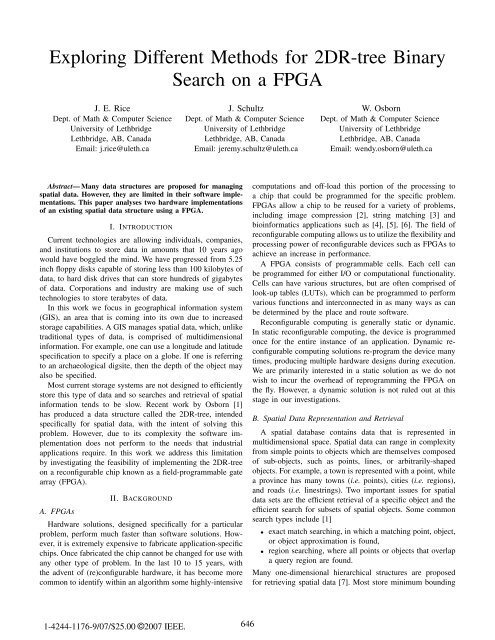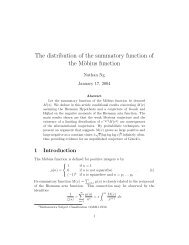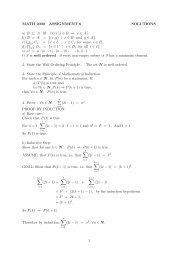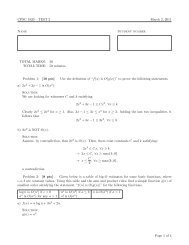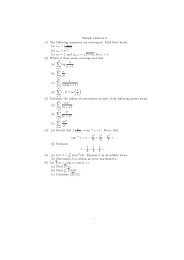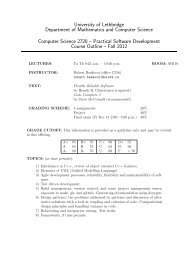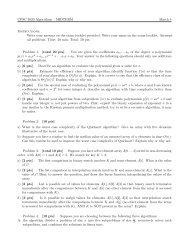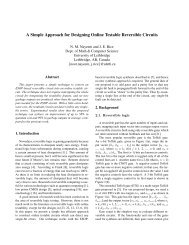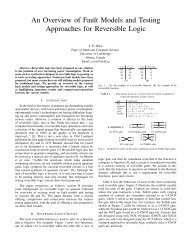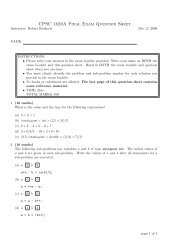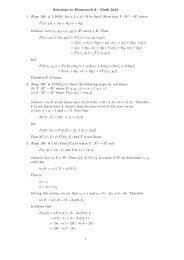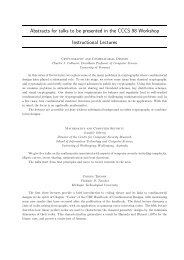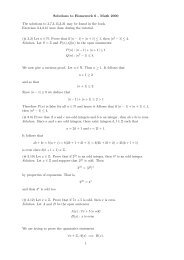Exploring Different Methods for 2DR-tree Binary ... - IEEE Xplore
Exploring Different Methods for 2DR-tree Binary ... - IEEE Xplore
Exploring Different Methods for 2DR-tree Binary ... - IEEE Xplore
Create successful ePaper yourself
Turn your PDF publications into a flip-book with our unique Google optimized e-Paper software.
<strong>Exploring</strong> <strong>Different</strong> <strong>Methods</strong> <strong>for</strong> <strong>2DR</strong>-<strong>tree</strong> <strong>Binary</strong><br />
Search on a FPGA<br />
J. E. Rice<br />
Dept. of Math & Computer Science<br />
University of Lethbridge<br />
Lethbridge, AB, Canada<br />
Email: j.rice@uleth.ca<br />
J. Schultz<br />
Dept. of Math & Computer Science<br />
University of Lethbridge<br />
Lethbridge, AB, Canada<br />
Email: jeremy.schultz@uleth.ca<br />
W. Osborn<br />
Dept. of Math & Computer Science<br />
University of Lethbridge<br />
Lethbridge, AB, Canada<br />
Email: wendy.osborn@uleth.ca<br />
Abstract— Many data structures are proposed <strong>for</strong> managing<br />
spatial data. However, they are limited in their software implementations.<br />
This paper analyses two hardware implementations<br />
of an existing spatial data structure using a FPGA.<br />
I. INTRODUCTION<br />
Current technologies are allowing individuals, companies,<br />
and institutions to store data in amounts that 10 years ago<br />
would have boggled the mind. We have progressed from 5.25<br />
inch floppy disks capable of storing less than 100 kilobytes of<br />
data, to hard disk drives that can store hundreds of gigabytes<br />
of data. Corporations and industry are making use of such<br />
technologies to store terabytes of data.<br />
In this work we focus in geographical in<strong>for</strong>mation system<br />
(GIS), an area that is coming into its own due to increased<br />
storage capabilities. A GIS manages spatial data, which, unlike<br />
traditional types of data, is comprised of multidimensional<br />
in<strong>for</strong>mation. For example, one can use a longitude and latitude<br />
specification to specify a place on a globe. If one is referring<br />
to an archaeological digsite, then the depth of the object may<br />
also be specified.<br />
Most current storage systems are not designed to efficiently<br />
store this type of data and so searches and retrieval of spatial<br />
in<strong>for</strong>mation tends to be slow. Recent work by Osborn [1]<br />
has produced a data structure called the <strong>2DR</strong>-<strong>tree</strong>, intended<br />
specifically <strong>for</strong> spatial data, with the intent of solving this<br />
problem. However, due to its complexity the software implementation<br />
does not per<strong>for</strong>m to the needs that industrial<br />
applications require. In this work we address this limitation<br />
by investigating the feasibility of implementing the <strong>2DR</strong>-<strong>tree</strong><br />
on a reconfigurable chip known as a field-programmable gate<br />
array (FPGA).<br />
A. FPGAs<br />
II. BACKGROUND<br />
Hardware solutions, designed specifically <strong>for</strong> a particular<br />
problem, per<strong>for</strong>m much faster than software solutions. However,<br />
it is extremely expensive to fabricate application-specific<br />
chips. Once fabricated the chip cannot be changed <strong>for</strong> use with<br />
any other type of problem. In the last 10 to 15 years, with<br />
the advent of (re)configurable hardware, it has become more<br />
common to identify within an algorithm some highly-intensive<br />
computations and off-load this portion of the processing to<br />
a chip that could be programmed <strong>for</strong> the specific problem.<br />
FPGAs allow a chip to be reused <strong>for</strong> a variety of problems,<br />
including image compression [2], string matching [3] and<br />
bioin<strong>for</strong>matics applications such as [4], [5], [6]. The field of<br />
reconfigurable computing allows us to utilize the flexibility and<br />
processing power of reconfigurable devices such as FPGAs to<br />
achieve an increase in per<strong>for</strong>mance.<br />
A FPGA consists of programmable cells. Each cell can<br />
be programmed <strong>for</strong> either I/O or computational functionality.<br />
Cells can have various structures, but are often comprised of<br />
look-up tables (LUTs), which can be programmed to per<strong>for</strong>m<br />
various functions and interconnected in as many ways as can<br />
be determined by the place and route software.<br />
Reconfigurable computing is generally static or dynamic.<br />
In static reconfigurable computing, the device is programmed<br />
once <strong>for</strong> the entire instance of an application. Dynamic reconfigurable<br />
computing solutions re-program the device many<br />
times, producing multiple hardware designs during execution.<br />
We are primarily interested in a static solution as we do not<br />
wish to incur the overhead of reprogramming the FPGA on<br />
the fly. However, a dynamic solution is not ruled out at this<br />
stage in our investigations.<br />
B. Spatial Data Representation and Retrieval<br />
A spatial database contains data that is represented in<br />
multidimensional space. Spatial data can range in complexity<br />
from simple points to objects which are themselves composed<br />
of sub-objects, such as points, lines, or arbitrarily-shaped<br />
objects. For example, a town is represented with a point, while<br />
a province has many towns (i.e. points), cities (i.e. regions),<br />
and roads (i.e. linestrings). Two important issues <strong>for</strong> spatial<br />
data sets are the efficient retrieval of a specific object and the<br />
efficient search <strong>for</strong> subsets of spatial objects. Some common<br />
search types include [1]<br />
• exact match searching, in which a matching point, object,<br />
or object approximation is found,<br />
• region searching, where all points or objects that overlap<br />
a query region are found.<br />
Many one-dimensional hierarchical structures are proposed<br />
<strong>for</strong> retrieving spatial data [7]. Most store minimum bounding<br />
1-4244-1176-9/07/$25.00 ©2007 <strong>IEEE</strong>.<br />
646
ectangles (MBRs) of objects and the regions in space that contain<br />
objects. Their limitations include overcoverage of empty<br />
space, and overlap of the MBRs, which leads to multiple-path<br />
searching. Because we propose the use of a multidimensional<br />
structure to store spatial data we avoid these problems.<br />
A. The <strong>2DR</strong>-<strong>tree</strong><br />
III. THE PROJECT<br />
This paper builds on work introduced by the authors in<br />
[8], which uses a two-dimensional hierarchical data structure<br />
<strong>for</strong> storage of objects in two-dimensional space. Using a<br />
hierarchical data structure with the same dimensionality as the<br />
data set leads to significant improvement in retrieval per<strong>for</strong>mance<br />
[1]. The <strong>2DR</strong>-<strong>tree</strong> supports the mapping of each MBR<br />
at every level to an appropriate location in a two-dimensional<br />
node, which reduces overlap and overcoverage. In addition, it<br />
reduces the number of nodes that need to be checked during<br />
searches, thereby improving retrieval per<strong>for</strong>mance.<br />
The <strong>2DR</strong>-<strong>tree</strong> differs from other spatial data structures in<br />
that the node locations are arranged in a node. Instead of a<br />
node being modeled as one-dimensional, it is in the <strong>for</strong>m<br />
of a two-dimensional array. A node can be broken down<br />
into individual node locations. These locations hold MBRs,<br />
which consists of two coordinate pairs high (x, y) and low<br />
(x, y). At the leaf level, an MBR represents an object, and<br />
its location in two-dimensional space is approximated in an<br />
appropriate location within a node. At the non-leaf level, an<br />
MBR represents a subspace that contains other MBRs, and its<br />
location is also approximated within a two-dimensional node.<br />
The order of a node is X ∗ Y , where X is the number of<br />
node locations on the x-axis and Y is the number of node<br />
locations on the y-axis. Figure 1 shows the layout <strong>for</strong> some<br />
sample objects, and the corresponding <strong>2DR</strong>-<strong>tree</strong> representing<br />
those objects is shown in Figure 2.<br />
Fig. 1.<br />
An example layout of various objects.<br />
Searching is done using a binary search algorithm. The main<br />
task generally involves deciding where to make the division;<br />
however as we will see in the following section the necessity<br />
<strong>for</strong> this is removed when implementing the search on the<br />
FPGA. In [8] we implemented a basic version of this concept.<br />
This paper builds upon this with a second implementation that<br />
solves many problems with our first method.<br />
Fig. 2. The <strong>2DR</strong>-<strong>tree</strong> storing the objects shown in Figure 1.<br />
B. FPGA Implementation<br />
For this work we used the Virtex-II Pro FPGA Prototyping<br />
Station, provided by the Canadian Microelectronics Corporation.<br />
It consists of an AMIRIX AP1000 development board<br />
that features the Xilinx Virtex-II Pro FPGA. It has 44,000<br />
logic slices, two embedded IBM PowerPC hard macros and<br />
1.4MB of on-chip RAM. We use the Xilinx ISE and Xilinx<br />
EDK software <strong>for</strong> development and simulations.<br />
The FPGA implementation of the <strong>2DR</strong>-<strong>tree</strong> structure closely<br />
matches the description in section III-A, except that the node<br />
location units also contain a pointer to related data about<br />
the object as well as logic to per<strong>for</strong>m the bulk of the work<br />
(i.e. checking two MBRs <strong>for</strong> overlap). In software it is also<br />
necessary to determine a split point <strong>for</strong> the binary search.<br />
However, the FPGA can check all nodes simultaneously, and<br />
there<strong>for</strong>e we do not need to find a division; instead all nodes<br />
on one level can be tested at once. The node location unit is<br />
designed to test <strong>for</strong> overlap between a given input MBR and<br />
the stored MBR and give the appropriate output.<br />
Along with the <strong>2DR</strong>-<strong>tree</strong>, it is also necessary to implement<br />
controllers to manage the input and output. Details of these<br />
controllers are given in [8]. Using the node location unit as<br />
the foundation, a node of any order can be created. The only<br />
in<strong>for</strong>mation stored at the node-level is the status of the node,<br />
i.e. leaf-node or not. The output from all node location units<br />
are passed out of the node unit as a group. The final step is<br />
to create, on the FPGA, a <strong>2DR</strong>-<strong>tree</strong> built from the individual<br />
nodes. Two issues arise when creating the <strong>2DR</strong>-<strong>tree</strong>. As the<br />
height of the <strong>tree</strong> grows the number of output MBRs increase<br />
drastically, as do the number of load MBRs. The input and<br />
output controllers solve the issue of handling the input and<br />
output loads, but <strong>tree</strong> size reamins a problem.<br />
IV. METHODS & RESULTS<br />
The goal of this work is to explore different FPGA implementations<br />
of the <strong>2DR</strong>-<strong>tree</strong> binary search. In this section we<br />
present the two methods that were compared and some results<br />
<strong>for</strong> each. The first method is based on the idea of representing<br />
the complete <strong>2DR</strong>-<strong>tree</strong> on the FPGA. However, in previous<br />
work we found that we quickly run out of room on the FPGA.<br />
The second method tries to overcome this shortcoming by<br />
using a queue of nodes to test <strong>for</strong> overlap.<br />
647
A. Method 1: Complete Tree<br />
In implementing the entire <strong>tree</strong> in hardware we gain an<br />
immediate speed increase from the ability to test several nodes<br />
<strong>for</strong> overlap at once. All nodes at each level in the <strong>2DR</strong>-<strong>tree</strong><br />
can be tested simultaneously. Assuming an order of 2∗2, then<br />
at the first level (the root node) one node is tested, followed<br />
by 4 at the next level, 16 at the level after that and so on.<br />
A <strong>tree</strong> of height 3 was intially used <strong>for</strong> the FPGA <strong>2DR</strong><strong>tree</strong><br />
per<strong>for</strong>mance analysis. The height restriction is due to the<br />
space limitation of the FPGA. Adding another level would<br />
require a larger FPGA. Since storage of the MBRs <strong>for</strong> each<br />
node location accounts <strong>for</strong> most of the space requirements,<br />
we are able to fit a <strong>tree</strong> of height 4 on the FPGA by reducing<br />
the range of the integers in the MBRs. This was done by<br />
using an integer with 16 bits instead of 31 bits, since the<br />
sample data does not exceed the range of a 16 bit integer.<br />
Further reduction in the range would allow <strong>for</strong> more levels to<br />
be added to the <strong>tree</strong>, but <strong>for</strong> analysis purposes the two sample<br />
<strong>tree</strong> heights will suffice. Two techniques <strong>for</strong> generating timing<br />
results are used: first, the implementation was simulated using<br />
the Xilinx software, and then the method was implemented<br />
and tested on the FPGA. Simulations were run on the sample<br />
data with <strong>tree</strong> heights of both 3 and 4. A <strong>tree</strong> of height 3<br />
has 21 nodes and 16 output nodes, while a <strong>tree</strong> of height<br />
4 has 85 nodes and 21 output nodes. Both <strong>tree</strong>s can be<br />
implemented with a clock cycle of approximately 12ns. Table I<br />
gives the results <strong>for</strong> per<strong>for</strong>ming searches with the varying<br />
height <strong>tree</strong>s. For the FPGA implementation the total time is<br />
Action FPGA Simulation Software<br />
Height=3 Height=4 Height=3 Height=4<br />
Initialize 6 ns 6 ns N/A N/A<br />
Load 264 ns 1,032 ns N/A N/A<br />
Search 48 ns 60 ns N/A N/A<br />
Query Output 216 ns 792 ns N/A N/A<br />
Total Time 534 ns 1,890 ns 13422 ns 20685 ns<br />
Further Searches 264 ns 852 ns no change no change<br />
TABLE I<br />
SPEED FOR VARIOUS ACTIONS IN PERFORMING A BINARY SEARCH ON A<br />
<strong>2DR</strong>-TREE (FPGA METHOD 1 COMPARED TO SOFTWARE).<br />
based on loading each node in the <strong>tree</strong>, per<strong>for</strong>ming the search<br />
and querying all the output nodes. Further searches do not<br />
include loading the <strong>tree</strong> with nodes. The time it takes <strong>for</strong> the<br />
data to transfer to the host PC and FPGA is not included<br />
in these calculations. For comparison, the last two columns<br />
of Table I give the timing results <strong>for</strong> the software binary<br />
search. These results were obtained by runing the <strong>2DR</strong>-<strong>tree</strong><br />
Java code. The only modification to the code was to add<br />
instructions <strong>for</strong> gathering the time it takes <strong>for</strong> the searches.<br />
Since a search takes a fraction of a second, several hundred<br />
searches were per<strong>for</strong>med and the average time was calculated<br />
from these results. There is a dramatic increase in speed using<br />
the FPGA, according to these simulated results. However, the<br />
results from execution of the binary search on the FPGA<br />
illustrate how much the data transfers slow down the search, as<br />
shown in Table II. Table II shows that incorporating the serial<br />
Baud Iterations Output Avg. Time<br />
Method per Search (ms)<br />
9600 100 Full 46.8<br />
9600 1000 Full 46.667<br />
9600 100 None 17.267<br />
9600 1000 None 17.334<br />
57600 100 Full 15.667<br />
57600 1000 Full 15.4<br />
57600 100 None 2.81*<br />
57600 1000 None –<br />
TABLE II<br />
FPGA (METHOD 1) BINARY SEARCH PERFORMANCE INCLUDING SERIAL<br />
COMMUNICATIONS.<br />
communication time requirements decreases the per<strong>for</strong>mance<br />
to a level far below the software results. Increasing the baud<br />
rate of the communications from 9600 to 57600 decreases<br />
the requirements, but not to an acceptable level. The output<br />
methods full and none refer to whether the search output is<br />
displayed. This allows us to determine the time required <strong>for</strong><br />
querying <strong>for</strong> the output. With a baud rate of 57600 and with<br />
output method none, the Java serial driver gives errors and so<br />
there<strong>for</strong>e complete results could not be reported. In addition,<br />
the * indicates that not all iterations were completed <strong>for</strong> this<br />
data set.<br />
From these results, running the binary search on the<br />
FPGA does not show any advantage. Increased communication<br />
speeds, such as sending in<strong>for</strong>mation via PCI bus, are necessary.<br />
The difference between the software and FPGA binary search<br />
may also reduce as the height of the <strong>tree</strong> increases, since the<br />
FPGA search time does not dramatically increase as the height<br />
of the <strong>tree</strong> grows while this tends to be the trend <strong>for</strong> the<br />
software implementation.<br />
B. Method 2: Overlap Queue<br />
In the previous method there is a restriction on <strong>tree</strong> height,<br />
imposed by the data requirements and the size of the FPGA.<br />
One way around this restriction is to split the main <strong>tree</strong><br />
into subsections and use the previous method to test each<br />
subsection. However, this could lead to loading of unneeded<br />
sections of the <strong>tree</strong>. This can be broken down even further.<br />
Instead of a complete subsection of the <strong>tree</strong> being tested <strong>for</strong><br />
overlap a single node can be tested.<br />
Using this method, the root node is added to a queue. The<br />
nodes in the queue are tested by a FPGA node. If a node<br />
location, from a non-leaf node, passes the overlap test, then<br />
the node it points to is added to the queue. Otherwise, if it<br />
is a leaf node and the node location passes the test, then that<br />
MBR is added to the found list. This cycle is continued until<br />
there are no nodes left in the queue. The pseudocode is:<br />
Add the root node to a queue<br />
While the queue is not empty<br />
Load and test the node on FPGA<br />
Query <strong>for</strong> the Node Location results<br />
If the Node Location passed the overlap test then<br />
If the node is a leaf-node then<br />
Add to the final results<br />
Else<br />
648
Add the child-node to the queue<br />
End if<br />
End if<br />
Unlike method 1, which communcates with software strictly<br />
<strong>for</strong> input and output, this method relies on a software/hardware<br />
combination. The queue must be implemented in software and<br />
the overlap test would be per<strong>for</strong>med on the FPGA. The queue<br />
software can, however, be run on the FPGA, since the board<br />
has a IBM PowerPC hard macro and onboard RAM.<br />
The advantages to this method are that it behaves just like<br />
a binary search and takes up very little room on the FPGA.<br />
It can prune branches of the <strong>tree</strong> as it per<strong>for</strong>ms the search. It<br />
can also handle any size of <strong>tree</strong>. The only limitations are the<br />
size of the queue in software. Additionally, since this method<br />
only needs one node <strong>for</strong> testing, it frees up room <strong>for</strong> additional<br />
units that can then be used to speed up insertion or deletion<br />
operations on the <strong>2DR</strong>-<strong>tree</strong>.<br />
This method is not completely implemented on the FPGA.<br />
Further work on the software side of the method is required;<br />
however, some results can be calculated <strong>for</strong> the computations<br />
to be carried out in hardware. The clock speed used in the<br />
calculations is based on the previous methods, and thus is set<br />
at 12ns. The reason <strong>for</strong> using the previous method’s clock<br />
cycles is because simulations of the overlap node do not give<br />
a clock cycle restriction. The single node has no complicated<br />
logic or mappings, and so should run at the FPGA’s max<br />
speed. Comparing the estimated simulation timings of the two<br />
Action Height=3 Height=4<br />
Initialize 6 ns 6 ns<br />
Single Test 12 ns 12 ns<br />
Best-case (1 path) 36 ns 48 ns<br />
Worst-case 252 ns 1020 ns<br />
Total Time (Method: Complete Tree) 534 ns 1890 ns<br />
TABLE III<br />
ESTIMATED SIMULATION TIMINGS FOR METHOD 2 OF THE FPGA-BASED<br />
<strong>2DR</strong>-TREE BINARY SEARCH.<br />
methods, the overlap queue method clearly is an improvement.<br />
This holds true even <strong>for</strong> the worst-case scenario where method<br />
2 has to per<strong>for</strong>m the overlap test on each node in the <strong>tree</strong>. It<br />
really shows its power if it can prune branches and does not<br />
test every node in the <strong>tree</strong>.<br />
As seen in the results from the last method, the communication<br />
latency increases the times <strong>for</strong> the FPGA methods<br />
considerably. Un<strong>for</strong>tunately, using serial communications there<br />
will be even more latency with method 2, since it depends<br />
on constant communication <strong>for</strong> each node. However one way<br />
to reduce the communication between the host PC and FPGA<br />
board is to load the <strong>tree</strong> in software on the FPGA. That means<br />
duplicating the <strong>tree</strong> to run on the IBM Power PC. The idea of<br />
creating the <strong>tree</strong> to run on the on-board processor of the FPGA<br />
board can be further extended. The insert and delete operations<br />
can be added to the software portion, and then certain node<br />
computations can be off-loaded to the FPGA. For instance,<br />
when inserting new data, it is necessary to determine where<br />
to add the data in the <strong>tree</strong>. The goal is to increase one node<br />
location’s MBR to encompass the new data; however, the node<br />
location that requires the minimum amount of increase must be<br />
found via a greedy search. This operation can be incorporated<br />
into the FPGA and the speed increase will come from being<br />
able to run the test on all node locations concurrently.<br />
V. CONCLUSION & FUTURE WORK<br />
The problem is how to fit a highly data-intensive problem<br />
onto a plat<strong>for</strong>m that is intended <strong>for</strong> highly computationallyintensive<br />
problems. We propose two methods <strong>for</strong> using a<br />
FPGA to per<strong>for</strong>m searches using a <strong>2DR</strong>-<strong>tree</strong> structure.<br />
Simulation of both FPGA-based methods <strong>for</strong> implementing<br />
and searching the <strong>2DR</strong>-<strong>tree</strong> show the potential <strong>for</strong> speed-up.<br />
The major bottleneck in both methods is the communication<br />
latency between the host PC and the FPGA board. Currently,<br />
this communication is being per<strong>for</strong>med via a serial cable.<br />
Future work will include using drivers <strong>for</strong> the FPGA board<br />
to communicate with the PC over the PCI bus. This would<br />
decrease the communication latency considerably.<br />
The second method, using an overlap queue, shows even<br />
more promise. Once the communication barrier is overcome,<br />
not only should this technique speed up searches, but also<br />
we anticipate that it will allow <strong>for</strong> the inclusion of other<br />
required data manipulation operations such as inserts, update<br />
and deletes. Further development in implementing the <strong>2DR</strong><strong>tree</strong><br />
on the FPGA board using processor macros is of great<br />
interest, and could provide the solution to the problems we<br />
are encountering since it would reduce the communication<br />
between the FPGA board and the host PC to simple relays<br />
of the users’ requests.<br />
REFERENCES<br />
[1] W. Osborn, “The 2dr-<strong>tree</strong>: a 2-dimensional spatial access method,” Ph.D.<br />
dissertation, University of Calgary, 2005.<br />
[2] A. Simpson, J. Hunter, M. Wylie, Y. Hu, and D. Mann, “Demonstrating<br />
Real-Time JPEG Image Compression-Decompression Using Standard<br />
Component IP Cores on a Programmable Logic Based Plat<strong>for</strong>m <strong>for</strong> DSP<br />
and Image Processing,” in Proceedings of Field Programmable Logic<br />
(FPL) 2001, LNCS 2147, Springer-Verlag, 2001, pp. 441–450.<br />
[3] H. Lee and F. Ercal, “RMESH Algorithms For Parallel String Matching,”<br />
in Proceedings of the 3rd International Symposium on Parallel Architec<br />
tures, Algorithms and Networks (I-SPAN’97), 1997, pp. 223–226.<br />
[4] K. B. Kent, J. E. Rice, S. V. Schaick, and P. A. Evans, “Hardware-Based<br />
Implementation of the Common Approximate Substring Algorithm,” in<br />
Proceedings of the Euromicro Symposium on Digital System Design:<br />
Architectures, <strong>Methods</strong> and Tools (DSD), 2005, pp. 314–320.<br />
[5] J. E. Rice and K. B. Kent, “Systolic Array Techniques <strong>for</strong> Determining<br />
Common Approximate Substrings,” in Proceedings of the International<br />
Symposium on Circuits and Systems (ISCAS), 2006, cdrom paper<br />
1480.pdf.<br />
[6] K. B. Kent, R. B. Proudfoot, and Y. Zhao, “Optimizing the Edit-Distance<br />
Problem,” in Proceedings of the 17th International Workshop on Rapid<br />
System Prototyping (RSP), 2006, to appear.<br />
[7] V. Gaede and O. Guenther, “Multidimensional Access <strong>Methods</strong>,” ACM<br />
Computing Surveys, vol. 30, no. 2, pp. 170–231, 1998.<br />
[8] J. E. Rice, W. Osborn, and J. Schultz, “Implementation of a Spatial<br />
Data Structure on a FPGA,” in Proceedings of the Second International<br />
Joint Conferences on Computer, In<strong>for</strong>mation, and Systems Sciences, and<br />
Engineering (CISSE), 2006, to appear.<br />
649


